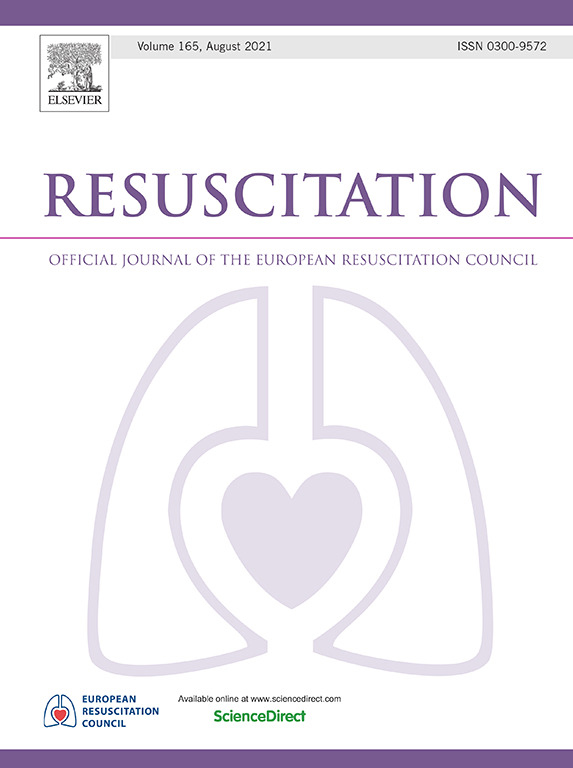中国院外心脏骤停的成年人接受外行旁观者心肺复苏和生存率的性别差异
IF 4.6
1区 医学
Q1 CRITICAL CARE MEDICINE
引用次数: 0
摘要
目的:评估中国院外心脏骤停(OHCA)患者在提供外行旁观者心肺复苏(BCPR)和生存结果方面的性别差异。方法:数据收集自2019年8月1日至2020年12月31日期间的OHCA基线调查(BASIC-OHCA)登记研究。我们纳入了有非创伤性骤停和复苏尝试的成年ohca。使用逻辑回归模型分析OHCA患者的性别与BCPR以及生存结果之间的关系,并对影响结果的与性别显著相互作用的因素进行亚组分析。结果:在33,333例OHCA患者中,10,650例(32.0%)为女性。男性外行人BCPR的发生率(19.5%)明显高于女性(17.3%)。多变量校正后,女性接受BCPR的可能性低于男性(校正优势比[aOR]=0.877, 95% CI: 0.804-0.957)。亚组分析显示,只有18-44岁的女性接受BCPR的可能性显著降低(aOR=0.588, 95% CI: 0.412-0.839),而旁观者目睹逮捕的女性接受BCPR的可能性较低(aOR=0.789, 95% CI: 0.701-0.887)。然而,在给调度员CPR指令的病例中,没有发现性别差异(aOR=1.175, 95% CI: 0.887-1.556)。出院或30天生存率(aOR=1.181, 95% CI: 0.884-1.576)和神经功能良好生存率(aOR=1.208, 95% CI: 0.848-1.721)无显著性差异。结论:在中国,女性OHCA患者接受BCPR的可能性低于男性OHCA患者,尤其是年轻女性和有旁观者目睹的逮捕。在给予调度员CPR指示的情况下,没有发现差异。本文章由计算机程序翻译,如有差异,请以英文原文为准。
Sex disparities in receipt of layperson bystander cardiopulmonary resuscitation and survival for adults who experienced out-of-hospital cardiac arrest in China
Aims
To assess sex differences in the provision of layperson bystander cardiopulmonary resuscitation (BCPR) and survival outcomes for patients with out-of-hospital cardiac arrest (OHCA) in China.
Methods
Data were collected from the Baseline Investigation of OHCA (BASIC-OHCA) registry study between August 1, 2019, and December 31, 2020. We included adult OHCAs with nontraumatic arrest and resuscitation attempts. Logistic regression models were used to analyse associations between the sex of OHCA patients and BCPR, as well as survival outcomes, with subgroup analyses by factors that significantly interacted with sex in influencing outcomes.
Results
Of 33,333 patients with OHCA, 10,650 (32.0 %) were females. Rate of layperson BCPR was significantly higher in males (19.5 %) than in females (17.3 %). After multivariable adjustment, females were less likely to receive BCPR than males (adjusted odds ratio [aOR] = 0.877, 95 % CI: 0.804–0.957). Subgroup analysis revealed that only females aged 18–44 years were significantly less likely to receive BCPR (aOR = 0.588, 95 % CI: 0.412–0.839) and females were less likely to receive BCPR with bystander-witnessed arrests (aOR = 0.789, 95 % CI: 0.701–0.887). However, no sex disparities were detected in dispatcher CPR instructions given cases (aOR = 1.175, 95 % CI: 0.887–1.556). There were no significant sex differences in survival at discharge or 30 days (aOR = 1.181, 95 % CI: 0.884–1.576) or in survival with good neurological function (aOR = 1.208, 95 % CI: 0.848–1.721).
Conclusions
In China, females with OHCA, particularly younger female individuals and with bystander-witnessed arrests, were less likely to receive BCPR than males with OHCA. No disparities were found in cases when dispatcher CPR instructions were given.
求助全文
通过发布文献求助,成功后即可免费获取论文全文。
去求助
来源期刊

Resuscitation
医学-急救医学
CiteScore
12.00
自引率
18.50%
发文量
556
审稿时长
21 days
期刊介绍:
Resuscitation is a monthly international and interdisciplinary medical journal. The papers published deal with the aetiology, pathophysiology and prevention of cardiac arrest, resuscitation training, clinical resuscitation, and experimental resuscitation research, although papers relating to animal studies will be published only if they are of exceptional interest and related directly to clinical cardiopulmonary resuscitation. Papers relating to trauma are published occasionally but the majority of these concern traumatic cardiac arrest.
 求助内容:
求助内容: 应助结果提醒方式:
应助结果提醒方式:


